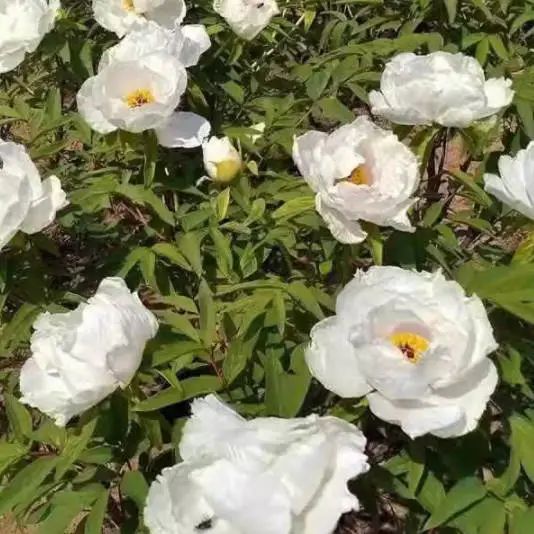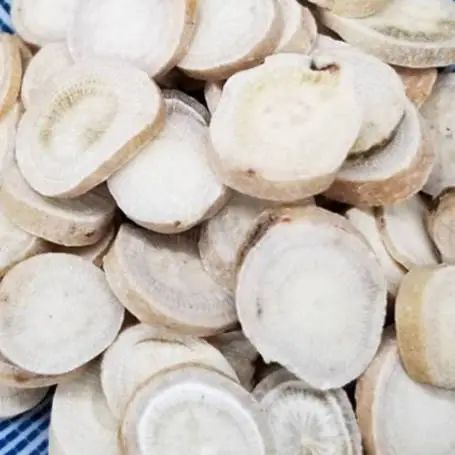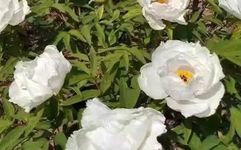Author: Tu Hao, Chief Pharmacist, Third People’s Hospital of Hubei Province



People often feel dryness in their bodies, experiencing symptoms of yin deficiency such as irregular menstruation and a pale complexion. Bai Shao (白芍, White Peony) is commonly used in autumn due to its properties of nourishing blood, regulating menstruation, and stopping sweating, as well as its ability to soothe the liver and alleviate pain. It helps to balance yin and yang in the body and relieve discomfort caused by seasonal changes, such as headaches, dizziness, and abdominal pain due to liver qi stagnation.

Nomenclature and Origins

Bai Shao was first recorded in the “Fifty-Two Diseases Formulas” during the Warring States period. The “Kaibao Bencao” from the Song Dynasty mentions two types of Bai Shao: Chi Shao (赤芍, Red Peony) and Bai Shao (白芍, White Peony), where Chi Shao promotes urination and dispels qi, while Bai Shao stops pain and disperses blood. In the “Bencao Gangmu” from the Ming Dynasty, Li Shizhen noted the distinction between red and white peony, stating that Bai Shao benefits the spleen while Chi Shao dispels pathogens.

Source and Characteristics

Bai Shao is the dried root of the herbaceous plant Peony (芍药, Shao Yao), belonging to the Ranunculaceae family. It is mainly distributed in Zhejiang, Anhui, and Sichuan provinces. This perennial herb has a thick, cylindrical root that is uniformly sized, with a solid texture and a cross-section that is whitish or slightly reddish and waxy.

Harvesting and Processing of Bai Shao

The harvesting of Bai Shao typically occurs in summer and autumn. After digging, the roots must be cleaned, removing the ends and fine roots. The processing involves boiling Bai Shao in water to remove the skin or peeling it before boiling, followed by drying. Various preparation methods exist, including slicing and drying, stir-frying, and wine processing, each affecting the medicinal properties.




Research on the Biochemical Components of Bai Shao

Bai Shao contains various chemical components, primarily including volatile oils, monoterpenes, triterpenes, and flavonoids. Among these, paeoniflorin and paeonol glycosides are the main active substances in Bai Shao.

Medicinal Value of Bai Shao

Bai Shao is bitter, sour, and slightly cold in nature, and it enters the liver and spleen meridians. It has the effects of nourishing blood, regulating menstruation, stopping sweating, softening the liver, and calming liver yang. Clinically, it is used to treat symptoms such as chest and abdominal pain, spontaneous sweating, night sweats, yin deficiency heat, irregular menstruation, metrorrhagia, and leukorrhea.

Dietary Recommendations

Bai Shao can be paired with various ingredients, such as in pain-relieving porridge, Bai Shao and winter melon soup, and stewed lean meat with Chai Shao and Dan Pi, each offering different therapeutic effects like soothing the liver, tonifying the spleen, and alleviating pain.
1
Four Treasures Lamb Porridge
Ingredients: Bai Shao, Shu Di Huang (熟地黄, Rehmannia), Dang Gui (当归, Angelica), Huang Qi (黄芪, Astragalus), lamb filling, rice, salt.
Effects: Tonifies both qi and blood, strengthens the spleen and kidneys.
2
Bai Shao and Yam Stir-fried Beef Tripe
Ingredients: Bai Shao, yam, beef tripe, scallions, ginger slices, salt, dark soy sauce, sugar, water starch.
Effects: Nourishes blood and qi, stimulates appetite, strengthens the spleen.
3
Bai Shao Stewed Pigeon
Ingredients: Bai Shao, goji berries (枸杞子, Gou Qi Zi), pigeon, ginger, water, salt, chicken essence, sugar, pepper.
Effects: Treats malnutrition, regulates menstruation, beautifies and nourishes blood.
4
Bai Shao and Dang Gui Honey Drink
Ingredients: Bai Shao, Dang Gui, processed He Shou Wu (制何首乌, Fo-Ti), honey.
Effects: Nourishes blood and qi, benefits essence and promotes growth.
5
Bai Shao Pain-relieving Porridge
Ingredients: Bai Shao, Huang Qi, Dang Gui, Ze Lan (泽兰, Lycopus), japonica rice, brown sugar.
Effects: Tonifies qi and blood, strengthens the spleen and stomach, alleviates pain.

Pharmacist’s Reminder

While Bai Shao is particularly suitable for supplementation in autumn, there are several points to note when using it:
1
Compatibility Contraindications:
Bai Shao is antagonistic to Mang Xiao (芒硝, Glauber’s salt), Shi Hu (石斛, Dendrobium), and is incompatible with Bie Jia (鳖甲, Soft-shelled turtle shell) and Xiao Ji (小蓟, Common Cirsium), and it is contraindicated with Li Lu (藜芦, Veratrum).
2
Use with Caution in Cold and Cool Constitutions:
Bai Shao is cold in nature; it should be used cautiously in cases of yang deficiency with symptoms such as poor appetite, abdominal distension, abdominal pain relieved by warmth and pressure, clear water regurgitation, cold extremities, or symptoms of heaviness and swelling, loose stools, and difficulty urinating.
3
Pregnant and Postpartum Women:
Li Shizhen noted in the “Bencao Gangmu” that “after childbirth, liver blood is already deficient, and further purging is not advisable, hence it is prohibited.” Pregnant women and those postpartum should avoid excessive dosages or sole use.
4
Drug Interactions:
The chemical components of Bai Shao contain monoterpenes, including paeoniflorin and paeonol glycosides, which may interact with Western medications. Therefore, when using Bai Shao, it is advisable to avoid combining it with Western medications that may interact, such as antihypertensives, cardiac glycosides, heparin, warfarin, and aspirin.
-END-
Images in this article are sourced from Shetu Network

This article is an original work by “PSM Yao Dun Public Welfare”. For reprints, please leave a message.
Reviewed by: Dai Yaqin, Deputy Chief Pharmacist, Third People’s Hospital of Hubei Province



Search for articles related to Bai Shao, this platform only provides educational content and does not sell medicine!

